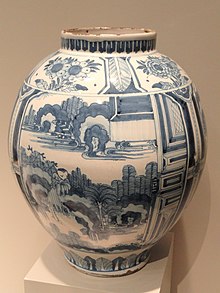
Back Delftse erdewerk AF الخزف الدلفي Arabic Faiança de Delft Catalan Delfter Blau German Fajenco el Delft EO Cerámica de Delft Spanish Delfti fajanss ET ظروف دلفت FA Faïence de Delft French Deilf (créghréithre) GA


Delftware or Delft pottery, also known as Delft Blue[1] (Dutch: Delfts blauw) or as delf,[2] is a general term now used for Dutch tin-glazed earthenware, a form of faience. Most of it is blue and white pottery, and the city of Delft in the Netherlands was the major centre of production, but the term covers wares with other colours, and made elsewhere. It is also used for similar pottery, English delftware.
Delftware is one of the types of tin-glazed pottery or faience in which a white glaze is applied, usually decorated with metal oxides, in particular the cobalt oxide that gives the usual blue, and can withstand high firing temperatures, allowing it to be applied under the glaze. Delftware forms part of the worldwide family of blue and white pottery, using variations of the plant-based decoration first developed in 14th-century Chinese porcelain, and in great demand in Europe.
Delftware includes pottery objects of all descriptions, such as plates, vases, figurines and other ornamental forms and tiles. The style originated around 1600, and the most highly regarded period of production is about 1640–1740, but Delftware continues to be produced. In the 17th and 18th centuries the manufacture of Delftware was a major industry, with product exported all over Europe.
- ^ Delft Blue, Holland.com
- ^
Rees, Abraham (1819) [1808]. "DELF". The Cyclopaedia; Or, Universal Dictionary of Arts, Sciences and Literature: In Thirty-nine Volumes. Vol. 11. London: Longman, Hurst, Rees, Orme & Brown. p. 74. Retrieved 9 November 2022.
DELF, or Delft-ware, Fr. Fayence, a kind of pottery of baked earth, covered with an enamel, or white glazing, which gives it the appearance and neatness of porcelain.